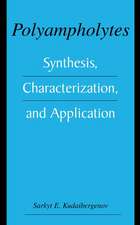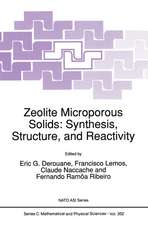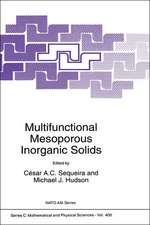Dynamic Chemical Processes on Solid Surfaces: Chemical Reactions and Catalysis
Autor Ken-ichi Tanakaen Limba Engleză Hardback – 15 feb 2017
In this book, the author determines that a surface is itself a new material for chemical reaction, and the reaction of the surface provides additional new materials on that surface. The revelation of that peculiarity is what makes this book different from an ordinary textbook, and this new point of view will help to provide a new impetus when graduate students and researchers consider their results.
The reaction of surface atoms provides additional new compounds, but these compounds cannot be detached from the surface. Some compounds are passive, but others work as catalysts. One superior feature of the surface is the dynamic cooperation of two or more different functional materials or sites on the same surface. This fact has been well established in the preferential oxidation of CO on platinum supported on a carbon nanotube with Ni-MgO at its terminal end. The Pt and Ni-MgO are perfectly separated, but these two are indispensable for the selective oxidation of CO in H2, where the H2O molecule plays a key role. The reader will understand that the complexity of catalysis is due to the complexity of the dynamic processes on the surface.
| Toate formatele și edițiile | Preț | Express |
|---|---|---|
| Paperback (1) | 722.26 lei 6-8 săpt. | |
| Springer Nature Singapore – 4 mai 2018 | 722.26 lei 6-8 săpt. | |
| Hardback (1) | 728.28 lei 6-8 săpt. | |
| Springer Nature Singapore – 15 feb 2017 | 728.28 lei 6-8 săpt. |
Preț: 728.28 lei
Preț vechi: 888.14 lei
-18% Nou
Puncte Express: 1092
Preț estimativ în valută:
139.38€ • 144.97$ • 115.06£
139.38€ • 144.97$ • 115.06£
Carte tipărită la comandă
Livrare economică 14-28 aprilie
Preluare comenzi: 021 569.72.76
Specificații
ISBN-13: 9789811028380
ISBN-10: 9811028389
Pagini: 192
Ilustrații: X, 192 p. 95 illus., 74 illus. in color.
Dimensiuni: 155 x 235 x 13 mm
Greutate: 0.46 kg
Ediția:1st ed. 2017
Editura: Springer Nature Singapore
Colecția Springer
Locul publicării:Singapore, Singapore
ISBN-10: 9811028389
Pagini: 192
Ilustrații: X, 192 p. 95 illus., 74 illus. in color.
Dimensiuni: 155 x 235 x 13 mm
Greutate: 0.46 kg
Ediția:1st ed. 2017
Editura: Springer Nature Singapore
Colecția Springer
Locul publicării:Singapore, Singapore
Cuprins
Introduction.- Surface Structures and the Crystalhabit of Growing Particles.- Self-Assembled Array of Atoms and Molecules on Metals.- Formation of quasi-Compounds on Metals.- Reaction of quasi-Compounds on Metal Surfaces.- Formation of Labile Surface Compounds and Catalysis.- Overview of Catalysis.- Spatial Distribution of Molecules Desorbing with Surface Reaction.- Formation of Active Ordered Layer on Pt-Rh Catalyst.- Dynamic Chemical Processes in Catalysis.- Concluding Remarks.
Notă biografică
Ken-ichi Tanaka received his Ph.D. at the Tokyo Institute of Technology. After becoming an associate professor at Hokkaido Univerisity and then at The University of Tokyo, he was a professor at The University of Tokyo. He now is professor emeritus at the University and a guest professor in the Research Center for Eco-Environmental Sciences, the Chinese Academy of Sciences; and honorary director at the Institute of Materials and Electrochemistry, the University of Science and Technology.
Ken-ichi Tanaka has received the Academic Award of the Chemical Society of Japan, the Award of the Surface Science Society of Japan, and the Award of the Catalysis Society of Japan.
He is an editorial board member of the Journal of Catalysis.
Textul de pe ultima copertă
In this book, the author determines that a surface is itself a new material for chemical reaction, and the reaction of the surface provides additional new materials on that surface. The revelation of that peculiarity is what makes this book different from an ordinary textbook, and this new point of view will help to provide a new impetus when graduate students and researchers consider their results.
The reaction of surface atoms provides additional new compounds, but these compounds cannot be detached from the surface. Some compounds are passive, but others work as catalysts. One superior feature of the surface is the dynamic cooperation of two or more different functional materials or sites on the same surface. This fact has been well established in the preferential oxidation of CO on platinum supported on a carbon nanotube with Ni-MgO at its terminal end. The Pt and Ni-MgO are perfectly separated, but these two are indispensable for the selective oxidation of CO in H2, where the H2O molecule plays a key role. The reader will understand that the complexity of catalysis is due to the complexity of the dynamic processes on the surface.
Caracteristici
Shows the unique property of surfaces by the dynamics of the reaction of surface atoms by STM Clarifies the role of active sites in catalysis by the molecular mechanism of a surface reaction Establishes the fine dynamic process in catalysis by in situ dynamic spectroscopy and isotope-labeled experiments Includes supplementary material: sn.pub/extras


























